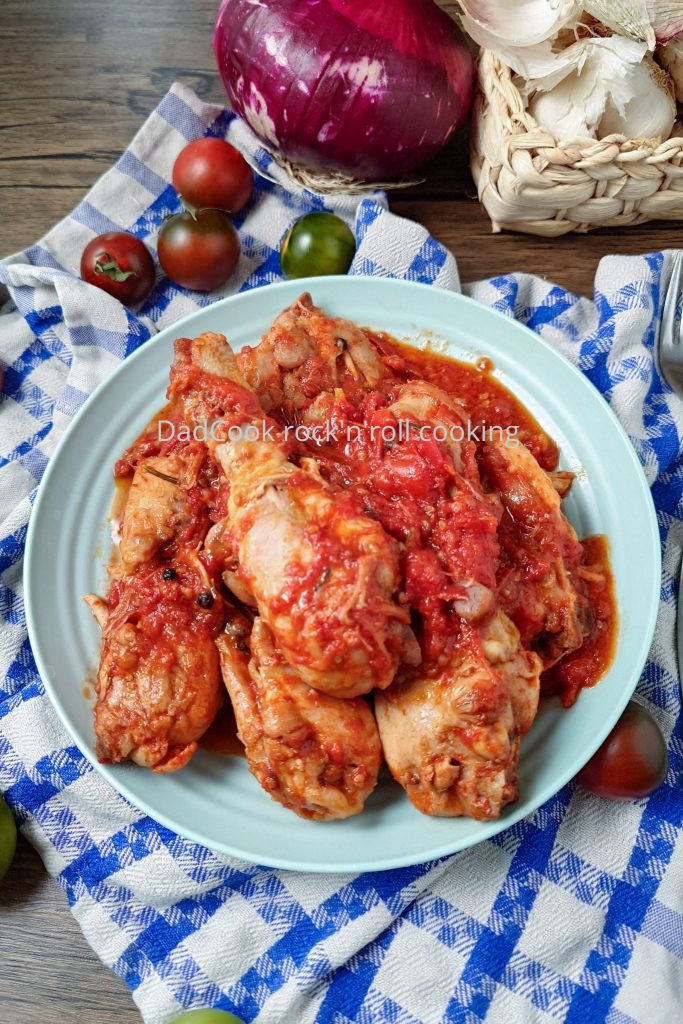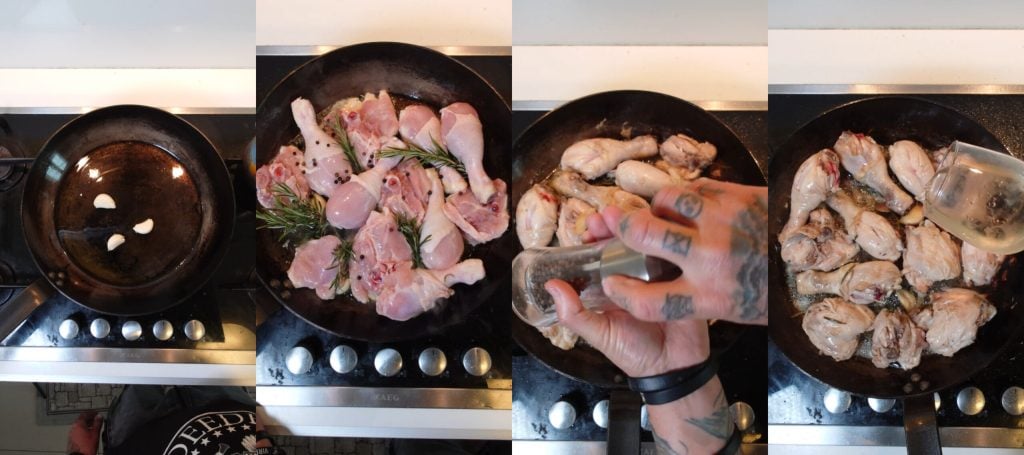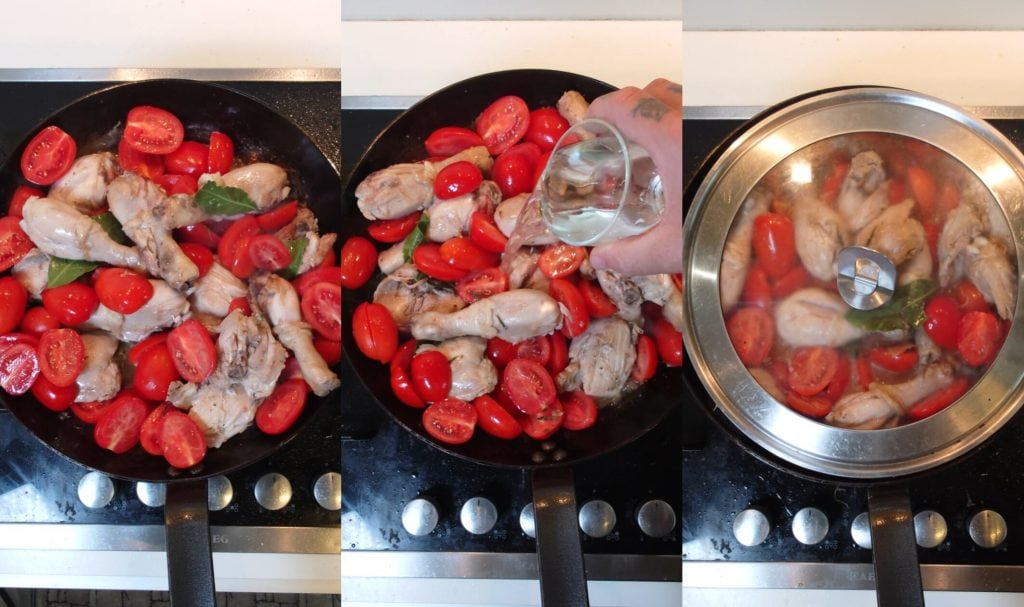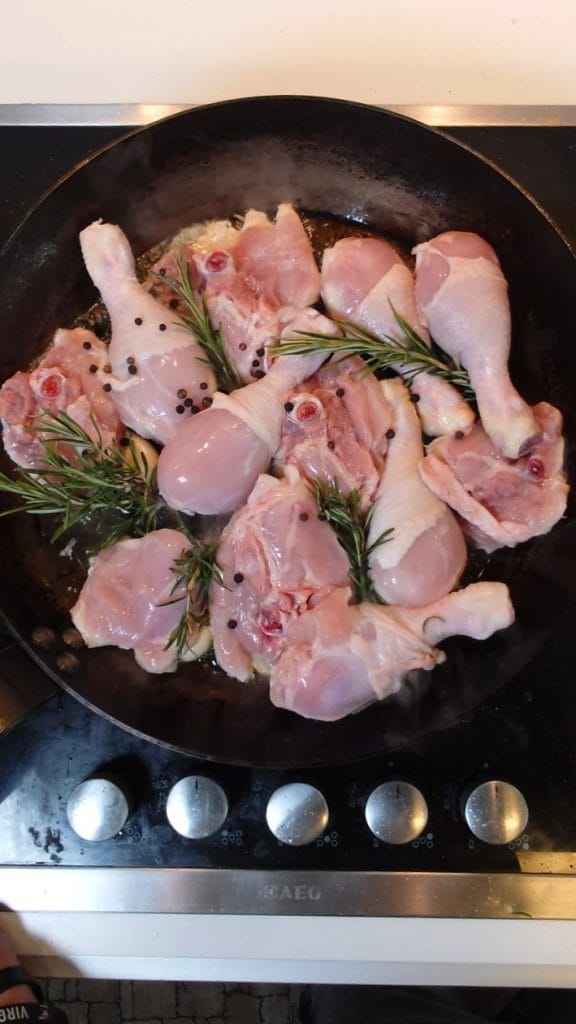Welcome to the rustic and authentic kitchen of Abruzzo!
Today we are preparing a dish that is a true symphony of simple yet bold flavors: Cif Ciaf Chicken.
Don’t be fooled by its curious and somewhat funny name; this recipe is a staple of peasant tradition, a main course that warms the heart and delights the palate with its succulent combination of free-range chicken, tomato, and intense aromas.
Perfect for a Sunday family lunch or a convivial dinner with friends, Cif Ciaf Chicken is more than just a stew: it’s a journey through the scents and customs of a strong and gentle land.
But where does this peculiar name come from? Let’s find out together
The name “Cif Ciaf” sounds almost like a children’s game or the noise of an animal, and indeed, its origin is linked to the sounds and concreteness of rural life of yesteryear, particularly in the Teramo area of Abruzzo.
The most well-known story, passed down from generation to generation, takes us back to when cooking was made of essential gestures and simple tools.
The term “Cif Ciaf” would be onomatopoeic and derived directly from the sounds produced during the preparation and cooking of this rustic dish.
Imagine the Abruzzese housewives of the past:
The “Cif!” could represent the sharp and decisive noise of the knife coarsely chopping vegetables (peppers, onions, tomatoes) and perhaps even the chicken into pieces.
There wasn’t time for elegant and precise cuts; cooking was substance.
The “Ciaf!” (or “Sciaf!”) instead, would recall the sound of ingredients being thrown energetically into the hot pan, perhaps greased with oil or lard, sizzling and immediately releasing their aromas.
It could also refer to the noise of the sauce gently simmering.
Thus, “Cif Ciaf” is nothing more than the “sound portrait” of preparing the dish: a colorful and immediate way to describe the action of cutting and cooking quickly, almost hastily but efficiently, as was done in the countryside where time was precious and meals had to be substantial and prepared with what was available.
There is no precise inventor or certain date of birth for this name, but it is the genuine expression of a popular gastronomic culture that, with few and simple words, managed to encapsulate the essence of a recipe.
A name that speaks of home, tradition, and that slightly hasty but full of flavor practicality that characterizes Abruzzese peasant cooking.
- Pan-fried Chicken: Thighs with Peppers, Easy Recipe for a Crunchy Crust:
- Lemon and Herb Chicken: A Fit and Tasty Main Dish
- Spiced Roast Chicken with Paprika and Curry: Crispy Outside, Tender Inside!
- Beer-braised Chicken Thighs
- Chicken with 40 Cloves of Garlic: The Perfect Recipe for Grandparents' Day

- Difficulty: Very Easy
- Cost: Economical
- Rest time: 10 Minutes
- Preparation time: 15 Minutes
- Portions: 4
- Cooking methods: Stovetop
- Cuisine: Italian
- Seasonality: Fall, Winter and Spring, All Seasons
- Energy 292.55 (Kcal)
- Carbohydrates 11.61 (g) of which sugars 13.94 (g)
- Proteins 27.51 (g)
- Fat 15.19 (g) of which saturated 4.84 (g)of which unsaturated 9.43 (g)
- Fibers 1.70 (g)
- Sodium 242.10 (mg)
Indicative values for a portion of 300 g processed in an automated way starting from the nutritional information available on the CREA* and FoodData Central** databases. It is not food and / or nutritional advice.
* CREATES Food and Nutrition Research Center: https://www.crea.gov.it/alimenti-e-nutrizione https://www.alimentinutrizione.it ** U.S. Department of Agriculture, Agricultural Research Service. FoodData Central, 2019. https://fdc.nal.usda.gov
Ingredients
- 2.2 lbs chicken (In pieces)
- 28 oz cherry tomatoes
- 2 cloves garlic
- 2 sprigs rosemary
- 4 leaves bay leaves
- Half cup white wine
- 1 cup water
- to taste extra virgin olive oil
- 1 pinch black pepper
- to taste salt
- Few grains whole black pepper
Tools
- 1 Cutting Board Freshmagis
Steps
Preparation of Aromatics and Tomatoes:
Start by focusing on the ingredients that will give fragrance and flavor to your dish.
Carefully wash the fresh rosemary sprigs and bay leaves.
Take the garlic cloves and, without peeling them completely if you prefer (or peeling them), place them on the cutting board and crush them vigorously with the palm of your hand or the flat side of a knife blade.
This simple gesture allows you to break the garlic fibers and release its essential aromatic oils more gently than a fine mince.
The garlic will release its flavor during cooking more sweetly and, if you prefer, you can identify and remove it more easily at the end of cooking.
Thoroughly wash your cherry tomatoes and cut them in half.
If they are very small, you can also leave some whole if you like to find them like that in the sauce. Set aside.

Aromatic Browning of the Chicken and Deglazing:
Take a large pan and pour a generous amount of extra virgin olive oil on the bottom.
Heat it over medium heat. Add the crushed garlic cloves and let them brown lightly for a few moments, being careful not to burn them, just long enough for the oil to take on flavor.
Then place your pieces of chicken (thighs and drumsticks, which are perfect for this preparation because they remain succulent) in the pan, trying not to overlap them for even browning.
Immediately add the rosemary sprigs and whole black pepper.
Move the garlic cloves over the chicken: This way, the garlic will continue to release its aroma without being in direct contact with the hot bottom of the pan, preventing it from burning and becoming bitter during the prolonged browning of the chicken.
Season the chicken with salt and freshly ground black pepper.
Brown the meat for about 10-15 minutes, turning the pieces with kitchen tongs on all sides until they are well browned and sealed.
Once the chicken is well browned, slightly increase the heat and deglaze with half a cup of dry white wine.
With a wooden spoon, gently scrape the bottom of the pan while the wine boils.
The wine helps to dislodge all the small caramelized and flavorful particles (the “fond”) that remained stuck to the pan during browning.
These particles are a concentrate of flavor that will incredibly enrich your sauce!
Let the alcoholic part of the wine evaporate completely for a couple of minutes, until you no longer smell its pungent odor.

Finish Cooking and Thicken the Sauce:
Let the chicken cook with the lid on for at least 30-40 minutes, stirring gently from time to time to ensure nothing sticks and cooking is uniform.
During this phase, the chicken will tenderize and the flavors will blend wonderfully.
After this time, check the chicken’s doneness: it should be tender.
Now remove the lid and continue cooking over a gentle-medium heat for another 15-20 minutes or until the sauce has thickened to the consistency you prefer.
During this phase, excess liquid will evaporate, concentrating the flavors.
The chicken will be perfectly cooked when the meat easily separates from the bone.
Taste the sauce and, if necessary, adjust the salt and pepper.

Rest, Plating, and Tasting:
Once the chicken is cooked to perfection and the sauce is inviting, turn off the heat.
Let everything rest in the pan, covered, for 5-10 minutes before serving.
This brief rest allows the juices of the meat to redistribute, making it even more tender and flavorful, and the flavors of the dish to further meld.
Now you are ready to plate up!
Serve your aromatic Cif Ciaf Chicken hot, accompanied by its delicious sauce.
It is perfect to enjoy with homemade bread for scooping up the sauce or with a simple side like roasted potatoes or a fresh salad.
Enjoy your tasting!

Storage, Variations, and Useful Tips:
Storage:
In the fridge: Once completely cooled, the cooked chicken can be stored in an airtight container in the fridge for 2-3 days.
Reheating: Gently reheat in a pan over low heat, adding a splash of water or broth if the sauce has thickened too much, or in the microwave.
Freezing: This type of preparation is also suitable for freezing.
Once cold, transfer it to freezer-safe containers and consume preferably within 1-2 months. Thaw in the fridge overnight before reheating.
Variations:
Mediterranean flavors: Try adding some pitted taggiasca olives along with the tomatoes for a more savory and Mediterranean touch.
A hint of spice: If you love bold flavors, increase the amount of fresh chili or add a pinch of chili powder during browning.
Other herbs: Besides rosemary and bay leaf, you can experiment with a couple of fresh sage leaves (as initially thought!) added during browning, or a sprig of thyme.
Richness of the sauce: For an even richer sauce, you can add a tablespoon of tomato paste at the beginning, before deglazing with the wine.
Various Tips:
Quality pays: Choosing a good free-range chicken and ripe, flavorful cherry tomatoes will truly make a difference in the final result.
Sopping up is a must: Don’t forget to accompany the dish with plenty of fresh homemade bread to soak up every drop of the delicious sauce!
Wine pairing: This chicken pairs well with a young and fruity red wine, not too structured, such as a Cerasuolo d’Abruzzo or a young Montepulciano d’Abruzzo. A full-bodied and aromatic white wine can also be an interesting choice.
Don’t rush: Slow and gentle cooking is the secret to very tender chicken and a well-blended sauce. Hope these insights are useful to enrich your recipe even further!
Frequently Asked Questions FAQs
Here are some answers to common questions that may arise while preparing this recipe:
QUESTIONS AND ANSWERS
Can I use chicken breast instead of thighs and drumsticks?
Yes, you can use chicken breast cut into pieces.
Keep in mind, however, that breast tends to dry out more easily than thighs and drumsticks.
Slightly reduce the browning and overall cooking times, ensuring it remains tender and juicy.
What can I use if I can’t find fresh cherry tomatoes?
If fresh cherry tomatoes are not in season or available, you can replace them with other sweet and flavorful small tomatoes like grape tomatoes or cherry tomatoes.
Alternatively, a good rustic tomato passata or quality canned tomatoes (preferably cherry or grape tomatoes in cans, drained from their preserving liquid) will work well.Can I use dried herbs instead of fresh ones?
Yes, if you don’t have fresh rosemary or bay leaves, you can use dried ones.
Remember that dried herbs have a more concentrated aroma: generally, a teaspoon of dried herbs is equivalent to about a tablespoon of fresh chopped herbs.
For bay leaves, one dried leaf is about equivalent to one fresh.How can I adjust the sauce consistency if it’s too liquid or too thick?
Sauce too liquid: Continue cooking without the lid for a few more minutes over low heat to let it evaporate and thicken.
Sauce too thick: Add a ladle of hot water or light vegetable broth until you reach the desired consistency.Can I omit the white wine?
White wine adds a level of flavor and acidity that enriches the dish, especially helping to deglaze the fond.
If you prefer to omit it, you can deglaze with an equal amount of light vegetable broth, to which you can add a teaspoon of apple cider vinegar or lemon juice for a touch of acidity.
The final flavor will be slightly different but still pleasant.

